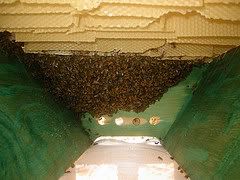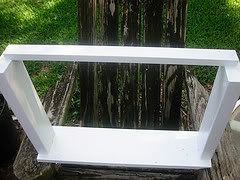Russian update...What is a KTBH
Yesterday, I went to check on the russian hive and figured I'd get some photos of the KTBH (Kenyan Top Bar Hive) aswell.
Russian Hive:
Oddly aggressive, the russian hive nearly chased me out. They were nervous on the comb, prone to stinging the gloves and were head-butting to an unusuall high. I went through the brood nest and they couldn't draw comb if their lives depended on it. They seem to like doing the opposite of what I want them to. They have about 4 of the ten frames in the brood nest completely drawn out (terrible), and, won't get off of my veil. A few headbutters are usuall but, when it gets over a dozen, with stinging, that can take the fun right out of it. On the plus side, the palmetto bloom is getting into full swing and, there is one full super on the hive. They had another super but, it was filling up aswell so, on went a box of foundation. I intended on taking photos of them but, I didn't want to open my pocket. I'm probably going to have to concider requeening them.
KTBH:

Here is a look at the cluster (intact) in the KTBH. (I've added the K for accuracy, there are really two types of top bar hives, and this tells which one.) As you can see, the swarms was clearly good sized given, the other half of the bees is out foraging. They are still covering bars 1-9. Just to give you an idea of the mesurements, the walls are 13 inches tall, the top is 22 inches wide and the bottom is 8 inches wide. That's a good sized cluster!

Here you can see the front of the KTBH (120º). The slope makes it easier to remove the fragile comb and, the bees confuse the sides for the bottom and attach less comb to the sides. The holes plugged with twigs are used for additional space in the entrance. There is a small gap on the top between the top bars and the side which, the bees are now using as an entrance. This photo was taken on a different location, before the bees were installed.

This is a bar holder used to hold the top bar and comb so that I can make corrections such as cutting comb. It is also used to hold the bar when the comb is cut for harvest. I usually leave it sitting under the hive and, wouldn't you know it, it fits just perfectly.
Russian Hive:
Oddly aggressive, the russian hive nearly chased me out. They were nervous on the comb, prone to stinging the gloves and were head-butting to an unusuall high. I went through the brood nest and they couldn't draw comb if their lives depended on it. They seem to like doing the opposite of what I want them to. They have about 4 of the ten frames in the brood nest completely drawn out (terrible), and, won't get off of my veil. A few headbutters are usuall but, when it gets over a dozen, with stinging, that can take the fun right out of it. On the plus side, the palmetto bloom is getting into full swing and, there is one full super on the hive. They had another super but, it was filling up aswell so, on went a box of foundation. I intended on taking photos of them but, I didn't want to open my pocket. I'm probably going to have to concider requeening them.
KTBH:

Here is a look at the cluster (intact) in the KTBH. (I've added the K for accuracy, there are really two types of top bar hives, and this tells which one.) As you can see, the swarms was clearly good sized given, the other half of the bees is out foraging. They are still covering bars 1-9. Just to give you an idea of the mesurements, the walls are 13 inches tall, the top is 22 inches wide and the bottom is 8 inches wide. That's a good sized cluster!

Here you can see the front of the KTBH (120º). The slope makes it easier to remove the fragile comb and, the bees confuse the sides for the bottom and attach less comb to the sides. The holes plugged with twigs are used for additional space in the entrance. There is a small gap on the top between the top bars and the side which, the bees are now using as an entrance. This photo was taken on a different location, before the bees were installed.

This is a bar holder used to hold the top bar and comb so that I can make corrections such as cutting comb. It is also used to hold the bar when the comb is cut for harvest. I usually leave it sitting under the hive and, wouldn't you know it, it fits just perfectly.
0 Comments:
Post a Comment
<< Home